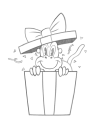Give a gift
Give a gift card for art students to use on anything in the Proko store.
Or gift this course:

About instructor
Freelance commercial illustrator and caricature entertainer. He’s done a lot of editorial and product illustration and concept work for film and TV.















Assignment
Your assignment is to take your rough sketches and apply abstraction to them. As you’re getting familiar with it, use the the step-by-step pdf below to help guide you.
Make sure you’re using the rhythms to improve your rough sketch. Don’t just trace over it. Look for ways you can improve the exaggeration and correct anatomical errors.